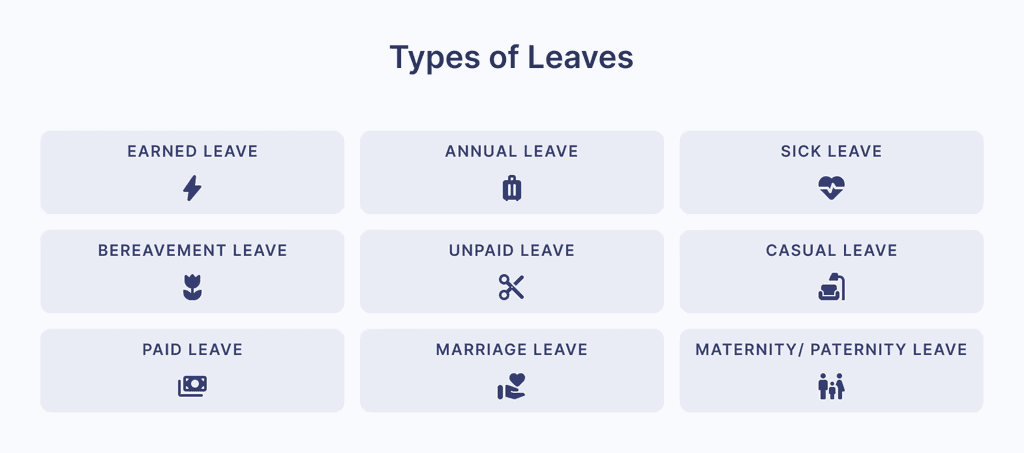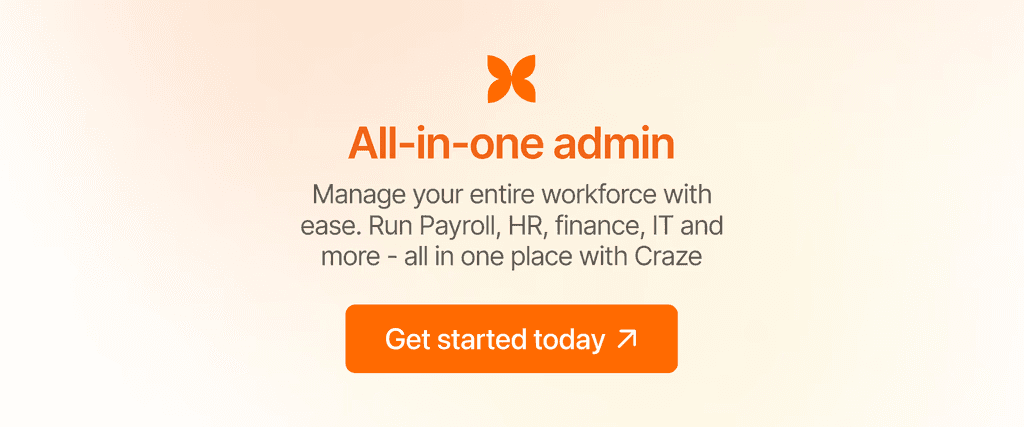The Ultimate Guide to Creating a Leave Policy for Employees [+Free Template]
Raise your hands 🙌, if…
You had to answer employee questions like – What’s the difference between sick leave, casual leave, and "I just need a break" leave?
You are not alone!
But you can’t avoid these questions either. For startups that don’t have a structured leave management guide and policy, HRs constantly struggle to create transparent leave policies.
This blog post is our attempt to help startups with their leave policy design. The best part? We are also including a leave policy template. Stay tuned till the end or click on the Free template section to find out.
What is a Leave Policy?
A leave policy is a document that outlines the rules for requesting and granting leaves. It specifies various types of leaves, how they are given, and what is required to authorise them.
Why is a Leave Policy Essential for Organisations
A leave policy in India for private companies is essential for several reasons:
It provides explicit guidelines for both employees and employers regarding leave entitlements and expectations
It enhances work-life balance and fosters a sense of fairness, ultimately boosting morale and job satisfaction
It ensures the company follows labour laws, reducing risks of penalties and legal disputes
It helps plan and manage work schedules, reducing disruptions
Types of Leaves
There are several types of leaves employees can take in a year, some are common and some not so common.

Common leave types
Casual Leave: Casual leave is for short, unplanned absences for personal reasons.
Paid Leave: Paid leave is a general term for various types of leaves paid for by the employer, such as casual, sick, or annual leave.
Sick Leave: Employees use this type of leave when they fall sick or get injured and require some time off to recover without losing pay.
Annual Leave: Annual or vacation leave is for personal rest and recreation. The duration can vary based on company policy or years of experience.
Earned Leave: Earned or privileged leave is accumulated based on the number of days worked in a month or year.
Unpaid Leave: Unpaid leave allows employees to take time off without pay after using all their paid leaves.

Bereavement Leave: Bereavement leave is given to employees to mourn the death of a close family member or friend.
Maternity/ Paternity Leave: Maternity leave refers to work breaks given to female workers before and after delivery for 26 weeks. Similarly, male employees are entitled to paternity leave per company policy. Usually, Central Government employees get 15 days.
Marriage Leave: Marriage leave is meant for employees whether they are getting married or one of their close relatives is.
Uncommon leave types
Menstrual leaves/Menopause leaves: While not officially recognised, some companies offer leave to female employees to cope with menstrual pain.
Compensatory Off: This leave is offered when the employee has worked on a public holiday or weekend for some urgent deliverables.
Non-smokers leave: This is a creative way to promote smoking awareness and compensate non-smokers for the regular smoking breaks taken by smokers.
Pawternity leave: This leave is offered to pet parents to take care of their furry friends.
Unlimited sick leave: While very uncommon, this leave does not count the sick days taken by employees. It shows employers trust them to take genuine leaves and get work done.
Structure of a Leave Policy

A comprehensive leave policy should include the following sections:
Introduction: A brief overview of the policy
Types of Leaves: Detailed descriptions of each type of leave
Eligibility Criteria: Conditions for taking leaves
Leave Entitlement: Number of days allotted for each type of leave
Application Process: How to apply for leaves
Approval Process: How leaves are approved
Leave Rules and Regulations: Guidelines for using and managing leaves
Compliance with Laws: Adherence to labour laws
Exceptions and Special Conditions: Any special provisions
Leave Policy Rules and Regulations
Once you have the list of leaves, you need to define the various rules for each leave type:

Granting leaves: procedures and approvals
This dictates the procedure for leave, which usually involves a leave application form and the approval of their immediate supervisor or HR.
Specify required forms, online portals to apply, or notification processes
Specify who (supervisor, HR, management) approves different leave types
Mandate necessary documentation like medical certificates, proof of family relationship, or other relevant papers are required

Leave entitlement: amount and frequency
Leave entitlements vary based on the type of leave and must be specified separately. For example, annual leave might accrue at one day per 20 days worked, while casual leave might be fixed at 12 days per year as per The Factories Act 1948.
Clearly define the number of days allotted for annual, sick, casual, and other leaves
Establish maximum leave balances to prevent excessive accrual
Expiry and carry forward: validity and expiry periods
Some types of leaves, like sick leave, may expire at the end of the year if not used. Others, like earned leave, can be carried forward to the following year.
Specify when unused leave lapses (e.g., end of year, specific date)
Define carryover rules to outline how much leave can be carried forward and under what conditions
Inform employees about impending leave expiration
Eligibility criteria: conditions for leave grants
Eligibility criteria include factors like employment status, duration of employment, and probation period.
Clearly define eligibility based on full-time, part-time, or contract employment
Determine the minimum length of employment for leave eligibility. For example, there is a no-leave policy until the probation/training period is completed
Detail requirements for maternity, paternity, bereavement, or other leaves
Specify the leaves that cannot be taken in conjunction with another. For example, not allowing sick leaves with annual leave
Prorating: adjustments based on the employment period
This process adjusts the leaves based on the length of service within a leave year. For example, if the leave years start in January and someone joins in July, they will get nine annual leaves instead of 18.
Determine the prorated leave entitlement based on the employee's start date
Use a specific formula to calculate the adjusted leave balance
Adjust leave for employees joining or leaving mid-month
Supplemental grants: additional leave for special conditions
Special leave grants may be provided for specific circumstances, such as additional sick leave for chronic conditions.
Specify criteria for granting additional leave (e.g., medical certificates, documentation)
Determine the maximum duration of supplemental leave
Indicate who authorises supplemental leave grants
Usage rules: applying for leave
Explain the detailed procedures and how and when employees can apply for leave, including any notice periods required.
Specify required advance notice for different leave types
Outline steps for submitting leave requests (forms, online portals)
Indicate necessary supporting documents (medical certificates, proof of absence)
Answer these questions:
Are half-day leaves allowed?
Are back-date leaves allowed?
What leaves must be applied before, and what can be availed after the event?
Is there any cooling period before taking a similar leave again?
Is there any limit to the maximum number of days of leave in a month?
Are leaves allowed during the notice period?
Encashment: converting leave to cash
This means encashing the accumulated earned leave balance at the end of the year when the leave cannot be carried forward to the next year.
Establish maximum amounts of leave that can be encashed
Describe how encashment payments are calculated and processed
Minimum accumulated balance of leaves required
Minimum and maximum number of days that can be encashed
Maximum number of instances that can be encashed
Annual rules: year-end policies and carry-forward
This dictated the rules for handling leave balances at the end of the leave year, including carry-forward and encashment provisions.
Specify the end of the leave calculation period
Indicate the maximum amount of leave that can be carried forward.
Explain how unused leave is treated at the end of the year, including the maximum leaves and the overall limit of leave balances that can be carried forward
Managing Weekends and Holidays
Let’s understand our ‘dear’ weekends and holiday policies, which must have a special place in the policy as they do in our hearts.
Integration of weekends in leave calculations
Integrating weekends in the policy explains how weekends are treated when they fall within a leave period.
For example, whether a weekend within a leave period is counted as leave or not, how many days are granted at weekends?
Weekend inclusion: Clearly state the off days. For example, some companies don’t have Saturday as a weekend holiday, while some have, and some treat it as a half day. Some companies allow alternate Saturdays as a holiday
Leave calculation adjustments: Specify how leave duration is adjusted if a leave period includes weekends
Holiday impact: Outline public and company holidays that may or may not affect leave calculations. For example, few companies offer optional public holidays that are paid for if not taken
Public and company-specific holiday policies
Guidelines on public holidays and any additional holidays specific to the company, such as founder’s day or company anniversaries.
Provide a list of recognised public holidays
Specify any additional holidays observed by the company
Outline how pay is calculated for employees working on public holidays
Explain how unused public holidays are handled at the end of the year
Key Elements of a Successful Leave Policy
Ensure that the leave policy for employees follows these for successful implementation:
1. Clear leave entitlements: The policy should be easy to understand.
Clearly outline each leave type (annual, sick, maternity, paternity, bereavement, etc.) and its purpose.
Transparent eligibility criteria for each leave type
Detailed leave accrual policy
2. Fairness: The leave policy should apply equally to all employees and to ensure this:
Ensure the policy is applied equally to all employees, regardless of role or department
Establish clear guidelines for impartial decision-making
Provide a clear mechanism for employees to dispute leave decisions
3. Flexibility: Allowing flexibility to accommodate special circumstances like medical emergencies or family crises.
4. Compliance: Ensure the policy adheres to all legal requirements and is regularly reviewed and updated to reflect legal changes.
Effective Implementation of Leave Policy for Employees
When the leave policy is created and approved by the management, follow these steps to roll it out:
Communicate the leave policy to all employees through multiple internal communication channels. Also, keep them informed about policy changes or revisions
Make it accessible for all on the company website, internal channels or portals
Provide training sessions to ensure employees understand the leave policy and how to use it
Regularly review and update the policy according to changing legal requirements
Use leave management software to automate approvals and effective tracking. Create a customised leave management system, auto-sync to payrolls, and stay compliant automatically

Ensuring Compliance with Indian Labour Laws
Designing a leave policy in India requires understanding and adhering to key legal policies. Here are some of the essential policies to consider:
The Factories Act, 1948
The Factories Act, 1948, mandates annual paid leaves for factory workers. Under this Act, every worker is allowed one day of leave for every 20 days of work.
Payment of Wages Act, 1936
The Payment of Wages Act, 1936, ensures employees receive their wages on time and without any unauthorised deduction.
The Shops and Establishments Act
The Shops and Establishment Act covers everything from hours of work, intervals for rest and meals, weekly holidays, wages for holidays, and more.The act ensures compulsory leave, including casual, sick, and earned leave, and it varies from state to state. For example, in Maharashtra, eight casual and five sick leaves are granted annually; in Karnataka, 12 sick and 18 earned leaves are granted.
The Maternity Benefit Act, 1961
The Maternity Benefit Act, 1961 provides 26 weeks of paid maternity leave for female employees.
The Minimum Wages Act, 1948 This Minimum Wages Act, 1948 ensures that leave policies do not result in wage deductions or reduce wages below the minimum prescribed limit.
The Payment of Gratuity Act, 1972
The Payment of Gratuity Act, 1972, mandates employers to account for leave encashment in gratuity calculations for employees with five or more years of service
Free Leave Policy Template
Below is a Leave Policy Template you can duplicate and use. Or you could use a leave management software like Craze.

Conclusion
Creating and implementing a leave policy for employees in India is not just a checkbox task. Investing time and effort in creating the perfect leave policy boosts morale, ensures fair treatment, and avoids non-compliance issues and disputes. It also shows that you value your employees' well-being.
If you are searching for a people operation tool that helps you create custom leave policies and integrates seamlessly with your payroll software to release accurate payouts within time, you need Craze.
Craze is appropriate for you if:
You are building people, finance and IT operations from scratch
You need a startup-proof leave management software that’s affordable and doesn’t restrict feature access
You need an empathetic support team that genuinely cares about your queries
Want to explore what Craze is capable of?

FAQs
What is leave encashment?
Leave encashment allows employees to trade unused leave days for money based on their salary. This applies to earned or privileged leave. Let's say an employee has ten days of earned leave at year's end. They can get paid for these days instead of carrying them over.
Are there any special leave provisions for specific circumstances?
Yes, some companies offer leave options for an employee's particular situation. These can include maternity leave when having a baby, time off to mourn a close relative's passing or leave to take work-related or educational tests.
Does the leave policy need to be different for work-from-home and work-from-office employees?
The core rules stay the same, but companies might need to tweak some aspects to fit different work setups.
How do we let workers know about the leave policy?
Share the information during team talks, in internal communication channels, through work emails, and staff guides. It's key that workers understand their rights and how to ask for time off.
What are some benefits of having a leave policy?
Benefits include increased employee satisfaction, legal compliance, improved operational efficiency, and the ability to plan workforce availability better.
Is it mandatory to have a leave policy?
A leave policy in India is essential for legal compliance and effective workforce management. It ensures that the organisation follows labour laws and provides a clear framework for employees to understand their entitlements.
